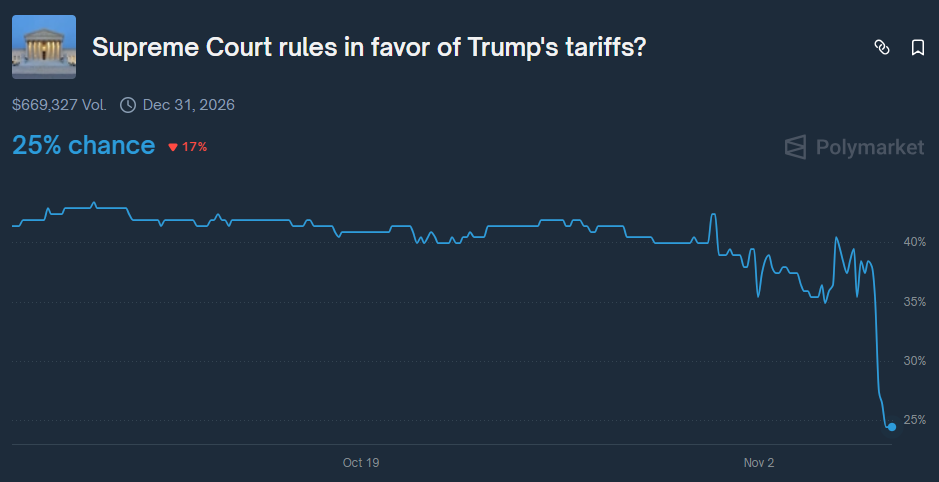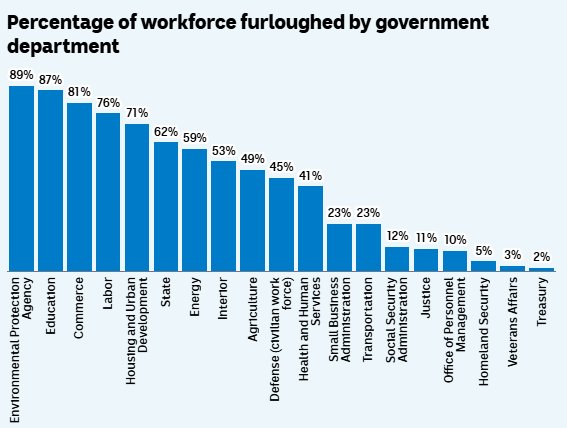Berita & analisis pasar
Tetap selangkah lebih maju di pasar dengan wawasan ahli, berita, dan analisis teknikal untuk memandu keputusan trading Anda.

Artificial intelligence stocks have begun to waver slightly, experiencing a selloff period in the first week of this month. The Nasdaq has fallen approximately 2%, wiping out around $500 billion in market value from top technology companies.

Palantir Technologies dropped nearly 8% despite beating Wall Street estimates and issuing strong guidance, highlighting growing investor concerns about stretched valuations in the AI sector.
Nvidia shares also fell roughly 4%, while the broader selloff extended to Asian markets, which experienced some of their sharpest declines since April.
Wall Street executives, including Morgan Stanley CEO Ted Pick and Goldman Sachs CEO David Solomon, warned of potential 10-20% drawdowns in equity markets over the coming year.
And Michael Burry, famous for predicting the 2008 housing crisis, recently revealed his $1.1 billion bet against both Nvidia and Palantir, further pushing the narrative that the AI rally may be overextended.
As we near 2026, the sentiment around AI is seemingly starting to shift, with investors beginning to seek evidence of tangible returns on the massive investments flowing into AI, rather than simply betting on future potential.
However, despite the recent turbulence, many are simply characterising this pullback as "healthy" profit-taking rather than a fundamental reassessment of AI's value.
Supreme Court Raises Doubts About Trump’s Tariffs
The US Supreme Court heard arguments overnight on the legality of President Donald Trump's "liberation day" tariffs, with judges from both sides of the political spectrum expressing scepticism about the presidential authority being claimed.
Trump has relied on a 1970s-era emergency law, the International Emergency Economic Powers Act (IEEPA), to impose sweeping tariffs on goods imported into the US.
At the centre of the case are two core questions: whether the IEEPA authorises these sweeping tariffs, and if so, whether Trump’s implementation is constitutional.
Chief Justice John Roberts and Justice Amy Coney Barrett indicated they may be inclined to strike down or curb the majority of the tariffs, while Justice Brett Kavanaugh questioned why no president before Trump had used this authority.
Prediction markets saw the probability of the court upholding the tariffs drop from 40% to 25% after the hearing.

The US government has collected $151 billion from customs duties in the second half of 2025 alone, a nearly 300% increase over the same period in 2024.
Should the court rule against the tariffs, potential refunds could reach approximately $100 billion.
The court has not indicated a date on which it will issue its final ruling, though the Trump administration has requested an expedited decision.
Shutdown Becomes Longest in US History
The US government shutdown entered its 36th day today, officially becoming the longest in history. It surpasses the previous 35-day record set during Trump's first term from December 2018 to January 2019.
The Senate has failed 14 times to advance spending legislation, falling short of the 60-vote supermajority by five votes in the most recent vote.
So far, approximately 670,000 federal employees have been furloughed, and 730,000 are currently working without pay. Over 1.3 million active-duty military personnel and 750,000 National Guard and reserve personnel are also working unpaid.

SNAP food stamp benefits ran out of funding on November 1 — something 42 million Americans rely on weekly. However, the Trump administration has committed to partial payments to subsidise the benefits, though delivery could take several weeks.
Flight disruptions have affected 3.2 million passengers, with staffing shortages hitting more than half of the nation's 30 major airports. Nearly 80% of New York's air traffic controllers are absent.
From a market perspective, each week of shutdown reduces GDP by approximately 0.1%. The Congressional Budget Office estimates the total cost of the shutdown will be between $7 billion and $14 billion, with the higher figure assuming an eight-week duration.
Consumer spending could drop by $30 billion if the eight-week duration is reached, according to White House economists, with potential GDP impacts of up to 2 percentage points total.


Brexit 23rd June 2016 – the day the people of United Kingdom voted to leave the European Union, it’s a day which will go down in the history and will always be remembered. The margin by which people voted to leave was not big (51.9% voted to leave, 48.1% voted to stay) but it will undoubtedly continue to have a big impact on the United Kingdom, European Union and the global financial markets. What does it mean to the UK economy?
Many leading economists before the referendum had been predicting an instant and significant impact on the UK economy and consumer confidence should the country leave the European Union, but so far, these predictions have not been accurate. Latest figures show that UK gross domestic product (GDP) in volume terms was estimated to have increased by 0.7% between Quarter 3 (July to Sept) 2016 and Quarter 4 (Oct to Dec) 2016, revised up 0.1 percentage points from the preliminary estimate of GDP published on 26 January 2017. Upward revisions (due to later data received) within the manufacturing industries is the main reason (these revisions were first published as part of the Index of Production for December 2016 released on 10 February 2017).
UK GDP growth in Quarter 4 2016 saw a continuation of strong consumer spending which is in line with the Retail Sales Index for Quarter 4, which grew by 1.2% (published on 20 January 2017) and strong growth in the output of the services sector with a notable contribution in consumer-focused industries. In Quarter 4 2016, there has been a slowdown within business investment which fell by 1.0%, driven by subdued growth within the “ICT equipment and other machinery and equipment” assets. Quarterly growth and levels of GDP for the UK source: www.ons.gov.uk Currency The pound fell to a to a 31-year low and was on course for its biggest one-day loss in history on the day the people of Britain voted to leave the European Union in June and has been steadily falling against the dollar since the vote.
When Theresa May announced that the UK would begin formal Brexit negations by the end of March, it did not do much to alleviate the concerns of investors about a ‘hard’ Brexit, negatively impacting Sterling once more. But what is keeping the Pound low? It’s uncertainty, uncertainty of how Brexit will turn out.
A notable portion of participants in the Forex market is made up of speculators and the consensus outlook they hold for a currency sometimes has a significant impact on its overall value, regardless of the impact from companies and individuals looking to move money for practical purposes. GBP/USD since the Brexit vote source: www.tradingview.com It is hard to predict to how, when or if, pound sterling will recover but there are some key things to keep an eye out for. > There could be a strong positive movement for pound sterling if the United Kingdom get a favourable exit deal with the European Union. > The Bank of England is not likely going to cut interest rates any further in the near term or put more money in the economy and that will be viewed as signs of confidence in the UK and will most likely make the pound more attractive. > UK Economic data will continue to have a significant impact on Sterling. If enough data suggests that the United Kingdom is in a strong position going into Brexit, for example if companies are continuing to hire and invest in the British economy and not planning to relocate to other EU countries, we should see renewed optimism in Sterling.
Meanwhile, stock markets have been strong since the Brexit vote. The FTSE100 closed at a record high at the end of 2016, up 14.4% during the year. FTSE100 since the Brexit vote Source: www.tradingview.com Key dates this month worth noting in the diary: Tuesday March 7 Deadline to pass the Brexit Bill - The May government wants the Lords to approve the Brexit bill by Tuesday March 7.
It will then need royal assent to become law. Thursday March 9 and Friday March 10 EU Summit: Should the bill pass in time, British Prime Minister May could decide to trigger Article 50 in Brussels. Friday March 31 The Prime Minister has publicly said that she plans to trigger Article 50 by the end of March 2017.
Triggering Article 50 will be followed by the arduous two-year process of the UK's break up with the EU.


Tesla Inc. (NASDAQ: TSLA) reported its Q3 2022 delivery numbers on Sunday. World’s largest automaker delivered a total of 343,830 cars (up by 42.49% year-over-year) in the third quarter – setting a new quarterly record. The deliveries in Q3 consisted of: 18,672 Model S/X 325,158 Model 3/Y The automaker produced 365,923 vehicles in Q3. ''Historically, our delivery volumes have skewed towards the end of each quarter due to regional batch building of cars.
As our production volumes continue to grow, it is becoming increasingly challenging to secure vehicle transportation capacity and at a reasonable cost during these peak logistics weeks. In Q3, we began transitioning to a more even regional mix of vehicle builds each week, which led to an increase in cars in transit at the end of the quarter. These cars have been ordered and will be delivered to customers upon arrival at their destination,'' the company said in the press release.
Tesla will report its Q3 financial results after the closing bell on Wednesday, October 19, 2022. Tesla Inc. (NASDAQ: TSLA) chart Shares of Tesla were down by around 6% on Monday at $247.90 per share. Stock performance 1 month: -1.84% 3 month: +71% Year-to-date: -24.70% 1 year: +65% Tesla price targets JP Morgan: $153 Piper Sandler: $340 Deutsche Bank: $400 Wolfe Research: $360 Jefferies: $350 Morgan Stanley: $383 Wedbush: $360 Tesla is the 6 th largest company in the world and with a total market cap of $825.19 billion.
You can trade Tesla Inc. (NASDAQ: TSLA) and many other stocks from the NYSE, NASDAQ, HKEX and the ASX with GO Markets as a Share CFD. Sources: Tesla Inc., GO Markets MT5, Benzinga, CompaniesMarketCap


The Reserve Bank of Australia, (RBA) has surprised much of the market by raising the country's cash rate by just 25 basis points. With analysts expecting a more aggressive 50 bps hike, the smaller lift will provide relief to much of the country's housing market and equity market. RBA, Chairman, Phillip Lowe outlined how previous rate rises had already begun struggling with the previous rate rises.
International volatility has also become much higher with retirement funds in the UK needing to be bailed out by the Bank of England after the funds found themselves inundated with the liquidity issues due to spikes in yield on many of the UK government bonds that they were holding. With the global financial system so interconnected there was a very real chance that a trillion dollars’ worth of bonds would be exposed without intervention effecting far more then just the UK’s financial system. In addition, worries over both Deutsche Bank and Credit Suisse also being in trouble with their risk of defaulting potentially increasing.
This had the RBA worried that the situation could turn very quickly in Australia and sparked the lower rate. With relatively low rates of inflation the RBA has had more flexibility to adjust the aggressiveness of its hikes as it has gone along and todays changes showed that. The bank still expects inflation for the year to be between 6-7 %.
In response to the hikes the AUD dropped sharply on the news falling by 0.52%. Australian equities saw a large jump increasing by 0.93% for the half an hour after the announcement. With inflation still at elevated levels, there is no guarantee that the lower rate hikes will continue.


I have recently written a piece on the weakening of the Great British Pound (GBP) just the other day, as it looks like the dollar seems to be king at present and getting stronger against all other top currencies around the world. Today is the Chinese Yuan in focus, yesterday was the Sterling pound, who’s your money on tomorrow? We will have to wait and see on that front, but lets quickly dive into why is the Chinese Yuan falling to record lows against the dollar?
The offshore yuan depreciated past 7.2 per dollar, sinking to its lowest levels since data on offshore trading became available in 2011, dragged down by a strong dollar amid expectations for more Federal Reserve rate hikes and a widespread risk aversion in the markets. The yuan also weakened despite efforts by authorities to arrest its slide which are so far having limited impact. In the latest developments, the People’s Bank of China raised the foreign exchange risk reserves for financial institutions when purchasing FX through currency forwards to 20% from the current zero starting on Sept. 28th, making it more expensive to bet against the local currency.
A gloomy domestic outlook also weighed on China’s currency, with Nomura and Goldman Sachs slashing their 2023 economic growth forecast for China sharply, predicting Beijing will stick to its strict zero-COVID strategy well into next year. China’s yuan recovered slightly after falling to a 14-year low against the $$$ Wednesday despite central bank efforts to stem the slide after U.S. interest rate hikes prompted traders to convert money into dollars in search of higher returns. At one point, the yuan fell to 7.2301 to the dollar, its lowest level since January 2008.
One yuan was worth about 13.8 cents, down 15% from its March high. As you can see below, the FEDs strategy has reinforced strength in the dollar, a currency that has been rising to records highs, is now contributing to economic pains in various jurisdictions around the world making more expensive for countries such as China, Japan and UK to name a few, to spend more on importing and making their debt even harder to manage, as they also try to keep on top of inflation by raising interest rates which in turn puts off investors who are looking for value in the market; followed by a run on certain currencies as seen with the GBP to bring it to parity (well almost) with the USD. The Dollar Against the World Currencies (As of 16:40 AEST 29/09/2022) There have been ample opportunities to get involved in the FX markets of late, if it’s not buying the dollar, it is to sell other currencies against it, but tread carefully markets are volatile and a sense of trading responsibly must be heeded.
If you would like to study the trends and take advantages of entry opportunities, you can do so by opening an MetaTrader trading CFD account with GO Markets here or find our contact details in the footer below. Sources: fortune.com, tradingeconomics.com


Many trading strategies utilise technical analysis to predict price patterns and for entries and exits. These strategies revolve often begin with the idea of the price having identifiable support, resistance and trendline market structures which indicate where various buying and selling points can be placed for a trade. These support and resistance indicate far more then just the price at a moment in time.
Rather they reflect the psychology of the market at a given point in time. However, when trading it is important to remember that the market is not just made of one type of trader. The market is made up of day traders, swing traders, scalpers, funds, hedge funds, retirement funds, Investment banks and all in between.
Each of these participants has their own time frame for a trade/investment. This element is the key as to why trader can utilise multiple time frame analysis. The theory it that the more market participant who view the respective level as a support or resistance, the more likely it will act in that way.
For example Assume that the price of stock A is sitting on a 5-minute support at $100. Looking purely at this 5-minute chart a trader may look to buy on this support level. However, after looking at the 30-minute chart, the chart shows that the price is not actually a support but rather just a random price point and therefor no trade is entered.
Alternatively, the 30-price chart supports the original price as a support and therefore may support the price point being a support point. How to implement multiple analysis into your trading. Determine your standard trading timeframe.
This step should be a relatively simple step if you have a clear edge. For some traders it can be 5 minutes, 15 minutes, 1 hour, one day or even one week. Work back usually by a factor a factor of 4/5 or by a logical time frame adjustment Prior to your first drawing of support resistance and trendline it is important that you adjust the timeframe of your price chart by a factor of 4/5 or a by logical adjustment such as an hour – to a day or day to week.
Example 5min – 30 min 1 hour – 4 hours 1 hour – day 1 day – 1 week 1 week – 1 month Add in Support and Resistance Lines on longer term time frames The analysis can now start, and the key is to draw the most obvious and consistent support and resistance time frames. This step also serves an important step in helping determine if the price is trending or is ranging. Revert to trading time frame and redo the same process highlighting convergences The next step is to revert to the desired trading time frame and conduct the same process.
This time if there is a Support/resistance line that is already made and acts as one on the shorter timeframe, highlight it or tag it. Looking at the example below for US car making company Tesla, the process is shown on the chart below. Firstly, with the weekly chart, support and resistance points were plotted with the black lines.
The below the daily chart shows that the support point at $265.25 acts as support for both timeframes. This indicates that price may act with more strength as a support zone. Similarly, if the level breaks it may indicate a more powerful move because more market participant will likely be involved.
In the other example for the EURUSD the same process has been done and shows that the price at 0.9600 is also doubling as a support on the daily and weekly charts. The use of multiple time frame analysis can optimise trading systems by reducing risks of fake breakouts and improving entry and exit accuracy.


Natural Gas prices have had a volatile year to say the least. After finding multi decade highs on the back of geo-political volatility and record high inflation levels the price has seen an aggressive retracement. With the overall commodities market suffering a big drop as recessionary pressures have taken over and a resilient USD, Natural gas has seen a 30 per cent drop from its peak.
News about leaks in the Nord Stream 1 Pipeline and Russia's control over much of the rest of Europe's supply has seen an increase of volatility and with Europe entering winter soon and the surety of supply still on a knifes edge, the market remains volatile. Looking at the recent price action of Natural Gas, the long-term chart shows that the current price is sitting on a strong area of support at 6 USD. Not only is the price sitting on a strong area of support, the area also doubles as the 200-day average.
The weekly candle is a Doji showing indecision as buyers and sellers look to find the equilibrium price. By comparing both the RSI from the weekly and daily charts its can be observed that there is interesting divergence of patterns. On the weekly timeframe, the RSI is consolidating into a symmetrical triangle whilst the daily RSI shows a bounce off the oversold zone.
This may provide a clue as to which direction the price may go next. If the price continues to bounce off the oversold level, it may indicate a longer-term break on the weekly chart. This bounce would provide an obvious target for a reversal to the long side to the top of the range at 10 USD.
With general market volatility still quite high and commodities seeing aggressive moves, the next 6-12 months may provide some interesting trading opportunities for natural gas in both directions.

